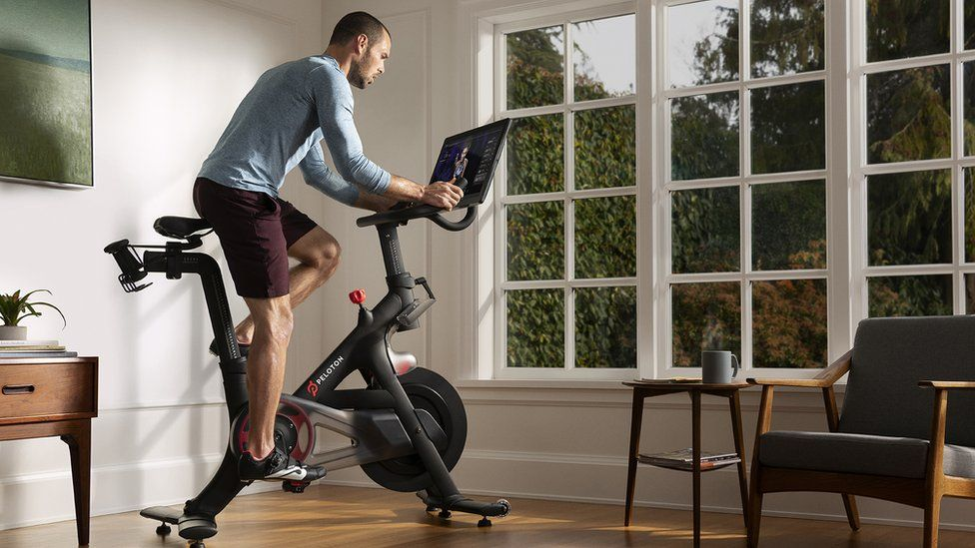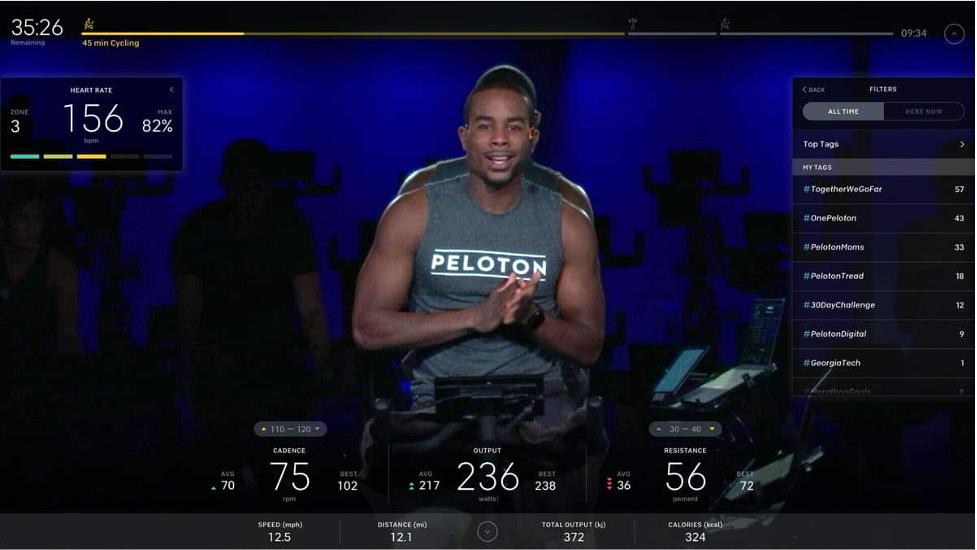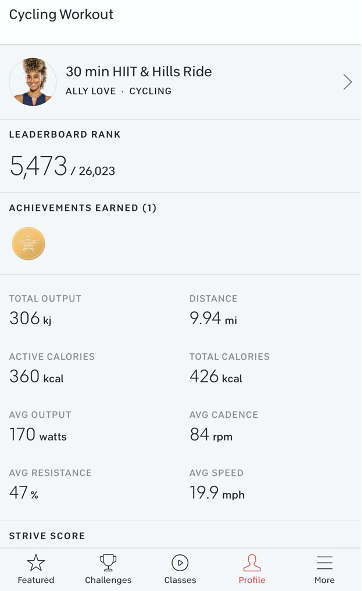I hit 306 on my bike this morning, and I’m psyched!
That may not be a super impressive number to an experienced Peloton rider, but I had never attended a spin class or ridden a stationary bike— or any kind of bicycle for that matter—until May. My household needed to shake off the sedentary vibe that took over during our collective transition to 100% remote work. So, we invested in a Peloton. (Figure 1)
 Figure 1: This is exactly what it looks like when I ride the bike. I swear! :-)
Figure 1: This is exactly what it looks like when I ride the bike. I swear! :-)
63 days ago, after recording an 88 during my first ride, I set a goal of reaching a 300 total output by the end of June. I hit my mark 23 days early during my 60th ride. YES!
I’ve learned a lot during the first two months of my latest fitness journey. I’ve learned that few things feel more dramatic than dropping your water bottle on the ground halfway through a ride when you’re clipped into the bike and firmly “in the zone.” I’ve learned that seat cushions are an absolute must in spin classes. And I’ve learned what happens when Cody Rigsby plays Britney Spears.
My biggest takeaway from two months of Peloton is just how many ideas L&D can borrow from connected fitness. The industry exploded over the past year and is expected to reach USD $59 billion in market size by 2027, up from an estimated $6.04 billion in 2019. Of course, this accelerated growth can be attributed to the extended closures of gyms and fitness centers during the pandemic. Unfortunate right place, unfortunate right time. However, just as remote work is morphing into a hybrid reality as offices reopen, many people (myself included) will maintain digital fitness routines when facilities are available.
Exercising at home isn’t new. I have a case of Shaun T workout DVDs to prove it. But modern technology has evolved the experience in ways that can inspire L&D solutions.
Progression
Fitness is iterative, just like learning. You get a little better a little at a time. However, without a coach there to provide consistent feedback, it can be hard to answer the question, “How am I doing?” (Figure 2) It’s easy to get discouraged because you don’t feel like you’re progressing.

Figure 2: The bike screen displays a variety of metrics to guide your ride experience
Peloton solves this problem with analytics. During a ride, on-screen metrics show me when I’m hitting or missing the mark based on the instructor’s guidance. Cadence and resistance indicators provide simple targets to follow, allowing me to focus on the factors that make the biggest difference in my workouts, such as form and breathing. (Figure 3)

Figure 3: Stats from my personal best ride — so far
I review my results in the mobile app after each ride. I don’t dig nearly as deep into the numbers as I could. Instead, I focus on my overall progression—how this ride compares to my previous entries. Going from an 88 to a 306 in two months made me feel great about the effort I’ve put into my workouts. If I’m not satisfied with the outcome of a ride, I do a more detailed review to figure out where I fell off and how I can improve tomorrow.
How can L&D apply data and analytics to help people understand their learning progression—both during and after training? Do you continuously measure factors such as knowledge growth and behavior change to help people recognize the real-world results of their learning efforts?
Engagement
Peloton uses an on-screen leaderboard as you work out. In the past, I’ve written about my experience applying gamification in learning programs. I’m a big believer in the effective use of engagement mechanics. So, you could assume I’d lean into this part of the Peloton experience. However, I don’t ride so I can compare myself to other people. I’m focused on my own progress. That’s why I’ve never looked at the leaderboard. That’s also why it’s a great feature—because I can turn it off.
Engagement is personal. What motivates me may not motivate you. Therefore, the best gamified systems allow users to make their own choices with regards to how they engage. Some will change their behavior to earn points, ascend the leaderboard, and capture rewards. Others will disengage if they’re forced into a competitive environment. It’s fun to scroll through my Peloton badge collection, but it doesn’t bring me back for the next ride.
How can L&D leverage flexible engagement tactics to help people connect with their personal motivations? Are you providing options with regards to how people engage with gamified systems so they can find their own learning value propositions?
Guidance
I give myself most of the credit for my progress with Peloton. But I don’t get all of the credit. The instructors are an essential part of my experience. They push me out of my comfort zone while keeping me focused on the right things during each ride. They can’t see me. They can’t provide targeted feedback. But they still always know when to say the right thing. At the beginning of the session, they remind me to focus on the basics, such as breathing and form. When I start to tire about two-thirds of the way through, they “get in my face” and boost my motivation. I schedule rides based on who’s teaching, not which times I prefer.
How can L&D partner with coaches and managers to make sure people receive the guidance they need to do their best work? Are you enabling managers with actionable insights they can use to improve their coaching conversations so they can say the right things at the right times?
Habit formation
I do four things every day:
? Take a walk while listening to a podcast (lots of Kara Swisher lately)
? Complete an Axonify training session
? Watch The Hockey Guy on YouTube
? Ride my Peloton
I feel incomplete if I don’t check these boxes. These activities have embedded into my day as habits. I’ve been doing some of them, like taking walks and logging into Axonify, for years. Peloton became a habit after just a few weeks. It began with my desire to get the most out of my household investment. But Peloton has definitely enabled my habit formation through their experience design.
- Workouts are available in a variety of durations. I typically ride for 30 minutes, but sometimes a 20-minute session fits better into my schedule.
- They offer a variety of workout types. If I’m bored or tired on a particular day, I can switch from a bike ride to an outdoor run and continue my progress.
- The mobile app will let me take my workouts on the road (eventually) so I can use a bike at a hotel or complete activities that don't require any equipment.
- I get weekly emails with progress summaries, personalized workout recommendations, and encouraging instructor messages.
- I know I went on and on about turning off the leaderboard, but I have to admit that I’ll be excited when I earn the “Century Club” 100 ride badge in July.
How can L&D help learning become a formal habit in the workplace? Are you designing solutions that fit into the workflow and nudge people to continue growing their knowledge and skill in ways that work best for them?
Experience inspires
Peloton’s mission statement is to “use technology and design to connect the world through fitness, empowering people to be the best version of themselves anywhere, anytime.” Now tell me that doesn’t sound a lot like what we do in L&D! No, I didn’t mean for this article to come across as one long ad for Peloton. My experience over the past two months has inspired me to recommit to my personal fitness, and I believe there’s a lot we can learn from Peloton’s approach and success.
Plus, I’m just really proud of that 306.
Be safe. Be well. Be kind to the frontline.
PS - Thanks to Ally Love, Alex Toussaint, Cody Rigsby, and Tunde Oyeneyin for their continued inspiration. If you also ride a Peloton, let’s connect! My username is “LearnGeek.”



